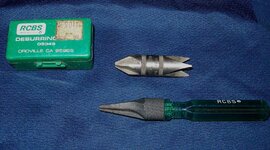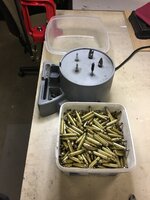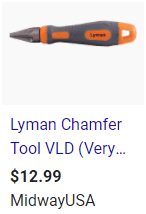Chamfering, that's the process of removing excess material inside a cartridge case mouth that has been trimmed. Deburring is the process of removing excess material that has flashed to the outside edge of the case mouth.
Of course most reloaders already know that rifle cases need to be chamfered even if they haven't been trimmed since their first firing. This is to remove the sharp edge in the case mouth that causes a new bullet to not seat properly. Boat tail bullets may not require a chamfered case mouth to start into the case mouth but the full diameter section of the bullet is still subject to scratching.
Once the inside of the case mouth has been chamfered, some bullets will seat without issues. Other times, it might be found that some degree of bullet shaving has occurred while seating the bullet. Even it it's a tiny amount of minute particles of bullet jacket material, like dust. I've never thought this would be a good thing.
Most of the chamfer tools offered for sale have a 45 degree cutting edge, so this is the edge that is imparted to the case mouth. Many flat base bullets will hit this and not like it. The result is shaving of the bullet jacket. Which cannot be seen with the bullet seated, but the dust will be observed, the shavings if you will.
If there are to be issues with bullet shaving using the 45 degree chamfer tool, the solution I've found is the RCBS VLD chamfer tool. The cutting edge on it is 22 degree, which gives the bullet a much friendlier angle to seat by. Here are the two types to compare:

The upper tool is the typical "rocket ship" RCBS tool with the 45 degree cutting edges. The lower one is the RCBS VLD chamfer tool. This is the hand version; the chamfer tool on the Trim Mate or whatever the motorized set is called comes with one of these.
I had the VLD tool without knowing what it was called. I had to look that up, it stands for Very Low Drag. RCBS description.
"The RCBS Chamfer and Deburring tool for VLD style bullets is ideal for cutting a 22 degree chamfer in the case mouth to help ensure VLD bullets are seated into the case without any damage. This tool can be used by itself or with the accessory handle or it can be mounted on the Trim Mate Case Prep Center (both sold separately). "
But I can't see how damaging a bullet while seating it can be beneficial for any bullet, not just VLD bullets. Even with a bullet having the sharpest flat base edges, they seat smoothly using the 22 degree chamfer tool. Lyman also makes one, but most of the remainder of such tools sold have a 45 degree cutting edge.
Of course most reloaders already know that rifle cases need to be chamfered even if they haven't been trimmed since their first firing. This is to remove the sharp edge in the case mouth that causes a new bullet to not seat properly. Boat tail bullets may not require a chamfered case mouth to start into the case mouth but the full diameter section of the bullet is still subject to scratching.
Once the inside of the case mouth has been chamfered, some bullets will seat without issues. Other times, it might be found that some degree of bullet shaving has occurred while seating the bullet. Even it it's a tiny amount of minute particles of bullet jacket material, like dust. I've never thought this would be a good thing.
Most of the chamfer tools offered for sale have a 45 degree cutting edge, so this is the edge that is imparted to the case mouth. Many flat base bullets will hit this and not like it. The result is shaving of the bullet jacket. Which cannot be seen with the bullet seated, but the dust will be observed, the shavings if you will.
If there are to be issues with bullet shaving using the 45 degree chamfer tool, the solution I've found is the RCBS VLD chamfer tool. The cutting edge on it is 22 degree, which gives the bullet a much friendlier angle to seat by. Here are the two types to compare:

The upper tool is the typical "rocket ship" RCBS tool with the 45 degree cutting edges. The lower one is the RCBS VLD chamfer tool. This is the hand version; the chamfer tool on the Trim Mate or whatever the motorized set is called comes with one of these.
I had the VLD tool without knowing what it was called. I had to look that up, it stands for Very Low Drag. RCBS description.
"The RCBS Chamfer and Deburring tool for VLD style bullets is ideal for cutting a 22 degree chamfer in the case mouth to help ensure VLD bullets are seated into the case without any damage. This tool can be used by itself or with the accessory handle or it can be mounted on the Trim Mate Case Prep Center (both sold separately). "
But I can't see how damaging a bullet while seating it can be beneficial for any bullet, not just VLD bullets. Even with a bullet having the sharpest flat base edges, they seat smoothly using the 22 degree chamfer tool. Lyman also makes one, but most of the remainder of such tools sold have a 45 degree cutting edge.









![IMG_9850[1].jpg IMG_9850[1].jpg](https://data.northwestfirearms.com/attachments/724/724806-5e639bfd9281adcf1b0616792cb8f7be.jpg)





